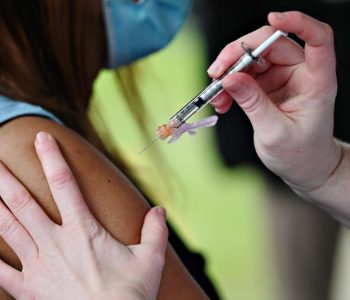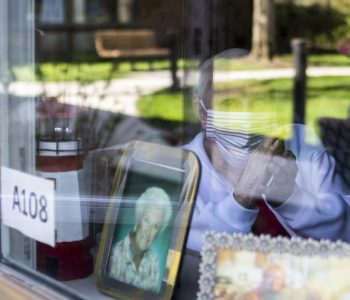Inmates in the state prison system are becoming increasingly aggressive toward staff due to the way the coronavirus pandemic is being handled, according to union officials and prison employees.
There’s also a shortage of healthcare staff to deal with the increasing number of inmates who have tested positive for COVID-19, workers said, adding that the Department of Correction has failed to take strong measures limiting the exposure of non-essential employees who are still required to show up daily.
About a dozen union officials representing thousands of DOC employees expressed their concerns Wednesday about increasing infection rates and how the agency is handling the pandemic after more than 150 inmates at Osborn Correctional Institution tested positive for COVID-19 last week.
“They need to be more proactive, not reactive,” said Sean Howard, President of AFSCME Local 387.
As of Wednesday, 371 staff members and 679 inmates have tested positive for COVID-19, union officials said. Six inmates number among the 3,529 Connecticut residents who have died of the disease. Mass testing occurring this week at Corrigan-Radgowski Correctional Center is raising concerns that like Osborn, high numbers of inmates could also test positive for COVID-19.
It’s a situation that has set employees up for failure, Howard said, even as DOC officials are calling for the unions to stop protesting.
“I hear, understand and share the unions’ frustrations, and I am doing everything within my power to address them,” DOC Commissioner Rollin Cook said. “However, we are operating during an unprecedented crisis, and collaboration is vital. At a time like this, unity is more important than ever, now is not a time for divisive words and actions. We are stronger together. To that end, I am grateful for everyone’s selfless efforts across our organization and I vow my commitment to work with the unions to reach mutually agreeable goals.”
Five of the six inmates who have died from COVID-19 were housed at Osborn, said LPN Gabby Bottino, who works at the facility. “There was a decision made to convert some of Osborn to COVID-19 units but we have no additional staff,” Bottino said. “We had an estimated 20 vacant nursing positions at Osborn even before the pandemic hit.”
Bottino and others said inmates are becoming increasingly agitated and blaming correction officers and medical staff for exposing them to the virus.
“Several nurses say the inmates said that it’s us that’s bringing it in,” said Kelly Schafer, a social worker at Carl Robinson Correctional Institution. “It does add a different level of danger.”
There have been several times that inmates were close to rioting since the pandemic started and numerous smaller disturbances, Schafer said.
“Their frustration is warranted,” Bottino said. “There is a complete lack of communication from central administration, they don’t know their test results. They are being moved, but no one is giving them their results whether or they are negative or positive.”
The inmates at Manson Youth Institution, which houses young males under the age of 21, are still eating together, sharing food, cutting each other’s hair and playing basketball, said Aaron Lichwalla, vice president, of AFSCME Local 387.
“It’s a recipe for disaster,” Lichwalla said.
No inmates at Manson Youth Institution have been tested for the virus, according to the testing results on the DOC website.
Lindsey Petralito can perform many of her functions by telework from home but she said she is still required to show up every day to her job as a medical records clerk at the Hartford Correctional Center. There is no alternating work schedule that would cut down on contact with others and no accommodation to do some of the work from home, she said.
“I ask that the Department of Correction help us in limiting our exposure to COVID-19,” Petralito said.
Employees at Osborn are pitching in to clean as often as possible, but what they want is a full lockdown to limit movement of inmates, Bottino said. “We need more custodial and more medical personnel on staff,” she said.
The concerns aren’t new, said Collin Provost, President of AFSCME Local 391. The unions pitched in to buy 10,000 masks since there is a shortage of personal protective equipment, and there initially was no plan to isolate inmates who were symptomatic or who tested positive for COVID-19 until the union pressed for changes, he said.
“The DOC failed to properly plan for the COVID-19 pandemic,” Provost said. “This pandemic isn’t going away.”
Some of the obstacles, such as the national shortage of PPE as the pandemic began, were beyond the control of the agency, said Karen Martucci, director of external affairs for the DOC.
Since then, the agency has been working with the union on an unprecedented level and when PPE was made available items have been handed out every week, Martucci said.
“Our commitment to protecting our employees can be seen in our policy that provides all employees, regardless of job classification or post assignment, with an N95 mask at facilities witnessing large numbers of positive COVID-19 cases,” she said. “This decision is above and beyond the Centers for Disease Control and Prevention recommendations. Also, all offenders have been issued more than one cloth mask and are required to wear them whenever outside of their cells.”
The agency continues to hire new health care staff during the pandemic and has 71 more staff members than this time a year ago, Martucci said. There were a total of 126 staff hired in the past year with 47 promoted, she said.
At the same time, she acknowledged that more staff have retired in the past two months throughout the agency than anticipated, but the DOC is continuing to recruit.
Martucci did not address staff concerns that inmates are becoming increasingly aggressive in their concerns about contracting the virus.



